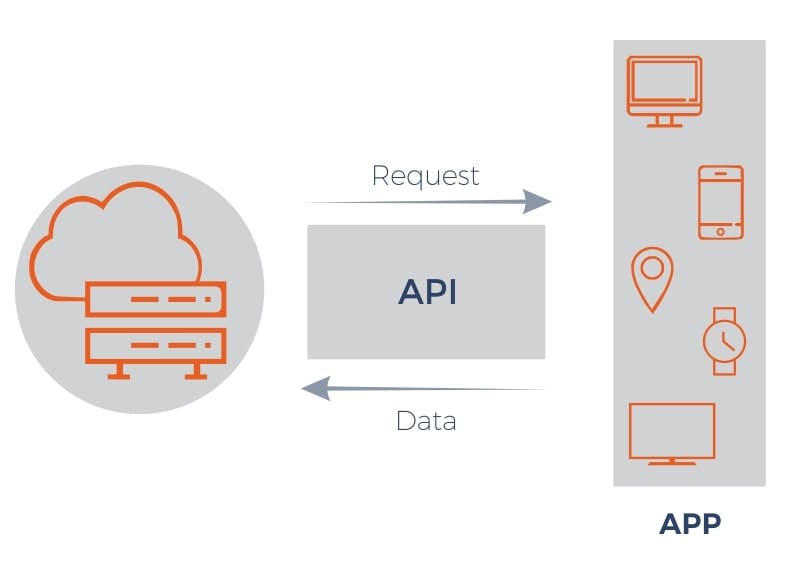Whether you're a developer or just someone curious about tech, you've probably heard of APIs but might not know exactly what they are. This blog will break down what APIs are and why they matter in a straightforward way, unraveling its functionality and significance within the tech landscape.
What Is An API?
API stands for Application Programming Interface. It enables interaction between software applications or mixed-hardware intermediaries via data transmission. We can also say API is a set of programming code rules that bridges the gap between data transmission from one software to another.
An API dictates how machines, computers, and applications communicate with each other. On the one hand, the user interface is for humans, and on the other, the API is for machines.
How Does API Work?
Let’s look at one of the examples of an API below.
Let's explore the analogy of a restaurant to understand API'S:
In this analogy, think of the waiter as an API, acting as a bridge between you, the diner, and the kitchen, which represents the webserver. When you place an order, you're essentially making an API call to the waiter, who then communicates your request to the kitchen staff. After a while, your order is delivered to you.
This scenario illustrates the principle of abstraction in software engineering, where complexity is simplified by focusing on essential details. Just as in the restaurant example, users don't need to comprehend the inner workings of the entire restaurant operation; they only need to know how to place an order.
Similarly, in web applications, abstractions exist at various levels. End-users are shielded from the complexities of APIs, just as applications are shielded from the intricacies of web servers.

Types Of API
APIs (Application Programming Interfaces) come in various types, serving different purposes and catering to different needs. Here are some common types:
Web APIs: These are APIs that are accessed over the web using HTTP or HTTPS protocols. They are typically based on standards like REST, SOAP, or GraphQL and allow interaction with web services, databases, or other online resources.
Internal APIs: Also known as private APIs, these are used within an organization or a company to facilitate communication between different internal systems, services, or applications.
External APIs: Also called public APIs, these are made available to developers outside of an organization to access certain functionalities or data. Examples include social media APIs, payment gateway APIs, or weather APIs.
Hardware APIs: These APIs provide access to hardware components or peripherals such as cameras, sensors, or GPS devices. They allow developers to interact with hardware functionalities from within their software applications.
Operating System APIs: Operating systems provide APIs that allow developers to interact with various aspects of the operating system, such as file systems, networking, or user interfaces. Examples include WinAPI for Windows, POSIX for Unix-like systems, and Cocoa for macOS.
Remote APIs: These are APIs that enable communication and interaction between different systems or devices over a network. Remote APIs can include RESTful APIs, SOAP APIs, RPC APIs, and others.
API Architecture
API architecture refers to the design and structure of an API, which dictates how clients interact with it and how it handles requests and responses. Here are some common types of API architectures:
Types Of API Architecture
REST API’s:
REST stands for representational state transfer and comes under the software design that gives users access to specific data by a predefined set of operations.
The four parts of REST are:
Headers
Body
HTTP
URI
You mainly refer to the REST APIs if you know about JSON (javascript object notation).
Over 70% of APIs available today use REST. The benefits of REST APIs are. They are:
Fast in performance
Have reliability
Ability to scale without affecting the entire system
SOAP API’s:
SOAP stands for Simple Object Access Protocol. The SOAP API is more complex than the REST.
This type of API was born in the 1990s. The SOAP API requires extra information about security and how it sends messages.
Browser API’s:
A browser can create incredible user experiences. These experiences include playing music, displaying animations, and others.
Web developers get the authority over these experiences via the browser API. They may use javascript to manipulate the HTML.
iOS Android APIs:
App developers have a specific set of APIs to build an experience for their audiences on a mobile platform.
Developers can use these APIs to transmit the data to the mobile device’s hardware. They can then use a sensor from that hardware device, including the camera playing videos and so on.
RPC (RemoteProcedureCall) API:
RPC APIs enable clients to invoke procedures or functions on a remote server, allowing them to execute code on a different machine over a network. RPC APIs abstract the complexity of network communication and provide a mechanism for inter-process communication.
WebSocket API:
WebSocket is a communication protocol that provides full-duplex communication channels over a single TCP connection. WebSocket APIs enable bidirectional communication between clients and servers, often used for real-time applications where constant updates are needed, such as chat applications or live data streaming.
These are just a few examples, and API architectures can vary based on the specific requirements, use cases, and technologies involved.
In conclusion, understanding APIs is essential for anyone involved in software development, system integration, or building modern applications. APIs serve as the bridge that allows different software components, systems, and services to communicate and interact with each other seamlessly. By providing well-defined interfaces and protocols, APIs enable developers to leverage existing functionalities, access data, and create new applications more efficiently.
Moreover, understanding APIs goes beyond technical knowledge; it involves considerations such as security, scalability, versioning, documentation, and developer experience. A well-designed API not only provides functionality but also ensures ease of use, reliability, and maintainability over time.
As technology continues to evolve and new challenges emerge, APIs will remain a fundamental building block of modern software development. By embracing best practices, standards, and design principles, developers can harness the power of APIs to create innovative solutions, drive digital transformation, and unlock new possibilities in the ever-changing landscape of technology.

